Cruiser (85 page)
Authors: Mike Carlton

HMAS
Perth
in the Battle of the Sunda Strait. Oil on canvas by Dennis Adams, 1964.
(
AWM
ART27557)
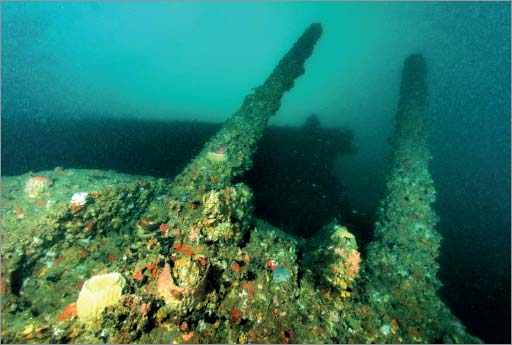
Perth'
s Y-turret, photographed in 2006. The blurred object in the background is the starboard side of the quarterdeck, ending in a jagged hole where a torpedo hit.
(K
EVIN
D
ENLAY
)
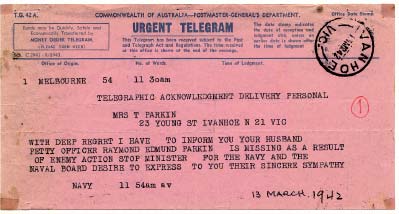
Telegram from the Naval Board to Ray Parkin's wife, Thelma, announcing he was missing in action. All
Perth
next of kin received the same message.
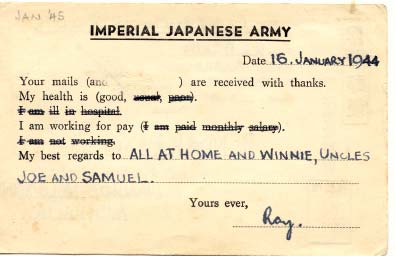
Most POWs of the Japanese were allowed to send a card like this to relatives at home. Ray Parkin wrote this in January 1944. It did not reach Melbourne for another year.
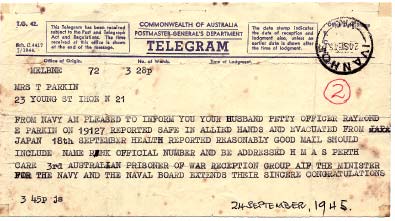
Better news from the Naval Board in 1945.
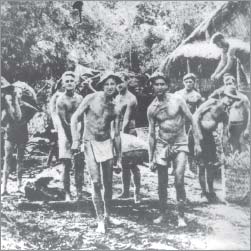
Australian POWs on the BurmaâSiam Railway, 1943. The man in the loincloth front left is
Perth
Able Seaman Ernie Toovey, who survived the war.
(B
RUCE
C
ONSTABLE
)
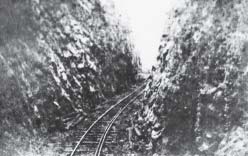
The railway at Konyu in Thailand, known to the prisoners as Hellfire Pass.
(
AWM
157859)
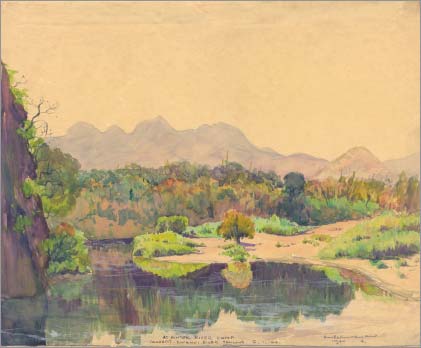
A view of Hintok River Camp, on the railway, 1944.
(W
ATERCOLOUR BY
R
AY
P
ARKIN
)
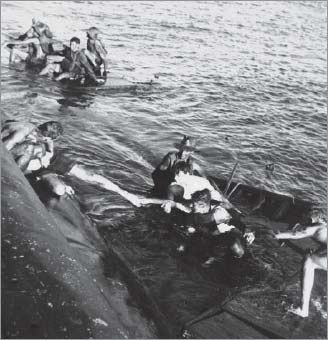
Allied POWs rescued from the South China Sea by the American submarine USS
Pampanito,
1944.
Pampanito
has been preserved at the San Francisco Maritime National Park.
(US N
AVY
H
ISTORICAL
C
ENTER
)
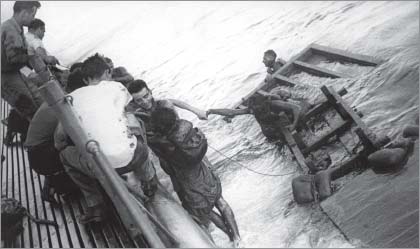
The submarine USS
Sealion
picks up more British and Australian POWs.
(US N
AVY
H
ISTORICAL
C
ENTER
)
REPORT BY COMMANDING OFFICER, HMAS
PERTH
Action Narrative â Day and Night Action off Sourabaya, 27 February 1942 (all times zone -71/2)
1. At about 1425 the Striking Force was approaching the minefields off Sourabaya. Squadron consisted of DE RUYTER (Flag), EXETER, HOUSTON, PERTH, JAVA, ELECTRA, ENCOUNTER, JUPITER, two Dutch destroyers and four US destroyers. The force was returning from an abortive sweep, carried out the night before.
2. At 1427 a message was received giving the position of the convoy in the vicinity of Bawean Island. DE RUYTER immediately turned 180° and led the force off to intercept. British destroyers were spread ahead, Dutch on the port quarter and US destroyers astern. The order of the cruisers was as in paragraph 1. HOUSTON's after turret was out of action due to a previous bombing attack.
3. At 1550, squadron was on course 315°, 24 knots. At 1614 an enemy cruiser was sighted on starboard bow. Speed was increased to 26 knots. Enemy now appeared as two 8 in. cruisers (Natai class) and ahead of them was one cruiser (Zintzu class) and six destroyers (Asashio class). At 1616 the enemy 8 in. cruisers opened fire at a range of 30,000 yards directing their fire mostly on EXETER and HOUSTON. ZINTZU opened fire about the same time on ELECTRA, at 1617 EXETER opened fire, HOUSTON at 1618.
4. DE RUYTER led round about 20° to port and range of 8 in. cruisers remained at about 26,000 to 28,000 yards for some time. PERTH could not open fire as the range was outside extreme, but at
about 1625 PERTH opened fire on the right-hand destroyers (the destroyers appeared to be moving in preparatory to attack). The second salvo hit, but immediately this destroyer and the others made smoke and retired behind a very effective screen with the cruisers. Several âfollow up' salvos were fired into the smoke.
5. DE RUYTER now led round to starboard. Enemy long range fire was extremely accurate, mostly pitching very close short or over. The spread was incredibly small, never more than 150 yards for elevation and much less for line. They were ten-gun salvos with extremely small splashes. Enemy aircraft were overhead the whole time, no doubt spotting.
6. At 16 35 DE RUYTER led towards the enemy on course 267°. About this time the rear enemy cruiser was evidently hit in the boiler room as she emitted very large clouds of black smoke for some time, but continued firing. As the smoke cleared, one enemy destroyer was seen to be on fire, and PERTH now came under a very accurate fire from the rear cruiser for a long period. The other cruiser was firing straight at EXETER and HOUSTON. PERTH was straddled several times and the salvos rarely fell less than one cable over or short. Every effort was made in handling the ship to estimate the correction the enemy would use.
7. The rear enemy cruiser was now on fire. PERTH was still out of range of enemy cruisers and I found a long period of being âAunt Sally' very trying without being able to return the fire. (Range was still over 26,000 yards.) The Dutch cruisers all this while were firing occasionally. At 1700, enemy cruisers checked fire. At 1702, the leading enemy cruiser appeared to be hit aft but both cruisers opened fire again. At 1707 the enemy destroyers delivered a long range torpedo attack and Allied cruisers had to turn away to let torpedoes comb the line. Allied cruisers ceased fire. Enemy still firing but shots falling short. At 1714 EXETER stopped and reported a hit in boiler room. She shortly proceeded at 15 knots and I closed her and screened her with funnel smoke and all available smoke floats. While doing this the Admiral made âAll ships follow me' but I continued to smoke screen EXETER and reported her damage to the Admiral who told me by V/S to follow him, when I proceeded to do so.
8. At 171 5 an Allied destroyer (I think ELECTRA) suddenly blew up close ahead of me, having, I think, been struck in the engine room by a torpedo. She capsized and dived under in a few seconds, then broke in halves, the two ends floating for some time. At 1718 PERTH's pom poms opened fire at a reported periscope. By 1721 some of our destroyers were screening EXETER with smoke: and others apparently attacking through the smoke. EXETER was steering 130° having been ordered to Sourabaya and PERTH trying to drive off spotting aircraft.
9. At 1725 Allied cruisers were led by the Admiral between EXETER and the enemy, presumably to draw their fire. Anyway, it did this and gave EXETER a breathing space and a chance to get out of the area. At 1729, DE RUYTER led away to the Southward; enemy cruisers were still firing very accurately. At 1745, Allied cruisers were again in single hit ahead (except EXETER) and emerged from the smoke screen on opposite course to the enemy 8 in. cruisers. (Enemy in sight were now the three cruisers and only five destroyers.) Whilst passing behind the smoke screen after circling EXETER, I was under a very accurate 8 in. fire continuously, although obviously the enemy could not see me. It was presumably radar control. At 1750 EXETER fired one salvo. At 1752 the enemy destroyers once more moved into attack and PERTH was firing, on destroyers as they came into view in gaps, in the smoke screen; the destroyers also peppered me for some minutes. At 1810 no Allied cruisers were firing, but there were several destroyer duels going on.
10. At 1812 our destroyers retired, and I found myself on opposite course to the two 8 in. cruisers at a range of 21,000 yards and engaged the right-hand ship. After getting in for line, the target was found and several rapid salvos got in on the target, two of which hit, and one of which caused a very big explosion aft in the target with volumes of bright lava-like emissions and a pink smoke. Both enemy cruisers then retired behind this smoke and a funnel smoke screen. When the smoke cleared away our target appeared to be stopped, the bow rose in the air and then seemed to settle back. We then lost sight of her, whether because she sank or whether the light failed I do not know.
11. During this engagement, HOUSTON was engaged with the left-hand cruiser, JAVA and DE RUYTER were both firing at something.
HOUSTON reported to me that she had very little 8 in. ammunition left and I informed the Admiral. By 1830 no enemy were in sight and DE RUYTER led our forces off to the Northeast, and subsequently (presumably) as requisite to try and work round the enemy escort and get at the convoy. Speed 22 knots.
12. At 1927 I sighted four ships on the port beam and reported them. The range was about 9000 yards, and about the same time, what I thought was a star shell but which was an aircraft flare, burst on our disengaged side and I opened fire at 1933 with main armament first, then tried star shell, but these fell short. HOUSTON also opened fire; I saw a row of explosions in one ship, but thinking these might be torpedo fire, I turned away, and all ships followed motions. JUPITER (on the port bow) moved in probably to counter-attack but there was no gunfire.
13. Cruiser s then formed up again in line ahead and were led on various courses by DE RUYTER to intercept. We seemed to drop a couple of destroyers in this last move. The search went on without event (except that we appeared to get into very shallow water). About 2100, whilst still in shallow water, one of the American destroyers blew up with a tremendous explosion and sank. At 2150, another aircraft flare appeared overhead and shortly afterwards a line of about 6 brilliant calcium flares in the water straddled our line at right angles. This happened every time we steered a new course and it was soon obvious that our every move in the moonlight was being reported, not only by W/T but also by this excellent visual means. The enemy's dispositions of his forces must have been ridiculously easy. At 2217, we passed through a very large number of survivors. They did not seem to be English, but may have been either Japanese or Dutch. I do not yet know if any Dutch ships were sunk.
14. At 2230, I sighted two cruisers on the port beam. HOUSTON reported them at the same moment. They were a long way off but one of them fired a salvo shortly after I sighted. I immediately opened a heavy fire on him and both cruisers opened up on us. This fire was extremely accurate again but very slow. Two of my salvos at least, and possibly three, struck home (we were spotting by moonlight). The same ship opened up with a stream of star shell and obliterated the target as they fell short. One enemy shell hit DE RUYTER on the Quarterdeck,
DE RUYTER turned 90° away and I followed as I thought he may have seen torpedoes. Whilst the line was halfway round this turn, the whole of JAVA's after part blew up and she stopped heavily on fire. She was not under gunfire at that time, so the explosion may have been due to a wandering fire or a torpedo. I suspect we were led over a submarine for almost at the same moment, although she had completed her 90° turn, DE RUYTER blew up with an appalling explosion and settled aft heavily on fire. I just managed to miss her by the use of full helm and one engine stopped. HOUSTON headed out to starboard. By now the American destroyers had been detached to Batavia to refuel, and all other destroyers had disappeared, possibly due to the frequent 90° turns done by DE RUYTER. The Admiral's verbal instructions had been that any ship disabled must be left âto the mercy of the enemy', to use his own words. I left DE RUYTER and JAVA, took HOUSTON under my orders, made a feint to the Southeast then turned direct to Batavia at high speed.
15. I had now under my orders one undamaged 6 in. cruiser, one 8 in. cruiser with very little ammunition and no guns aft. I had no destroyers. The force was subjected throughout the day and night operations to the most superbly organised air reconnaissance. I was opposed by six cruisers, one of them possibly sunk, and twelve destroyers. By means of their air reconnaissance they had already played cat and mouse with the main striking force and I saw no prospect of getting at the enemy (their movements had not reached me since dark, and even then the several reports at the same time all gave different courses).
16. It was fairly certain that the enemy had at least one submarine operating directly with him, and he had ample destroyers to interpose between the convoy and my approach well advertised as I knew it would be. I had therefore no hesitation in withdrawing what remained of the striking force and ordering them to the pre-arranged rendezvous after night action â Tanjong Priok.
Â
(Signed) H. M. L. WALLER,
Captain, RAN
